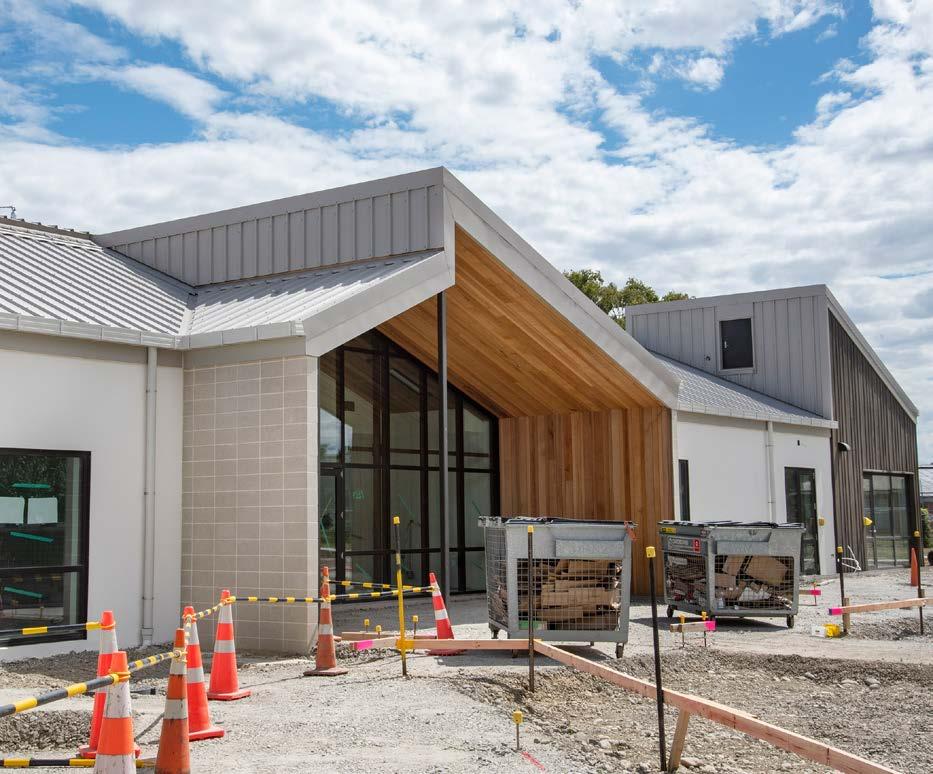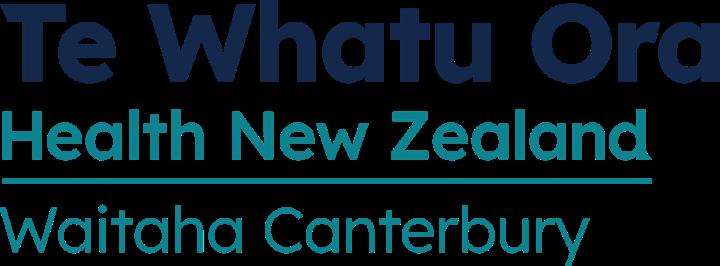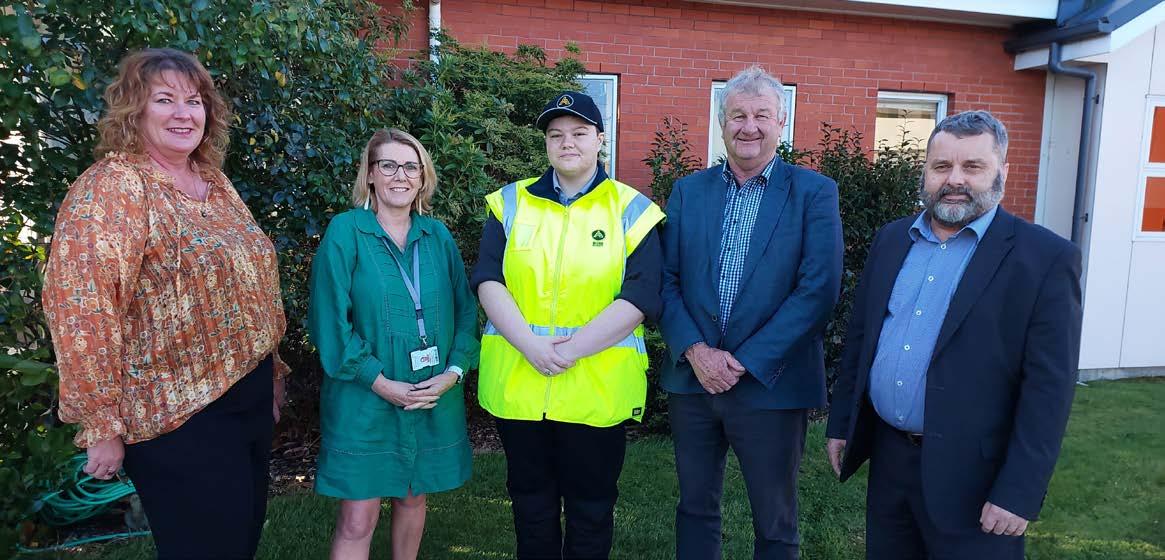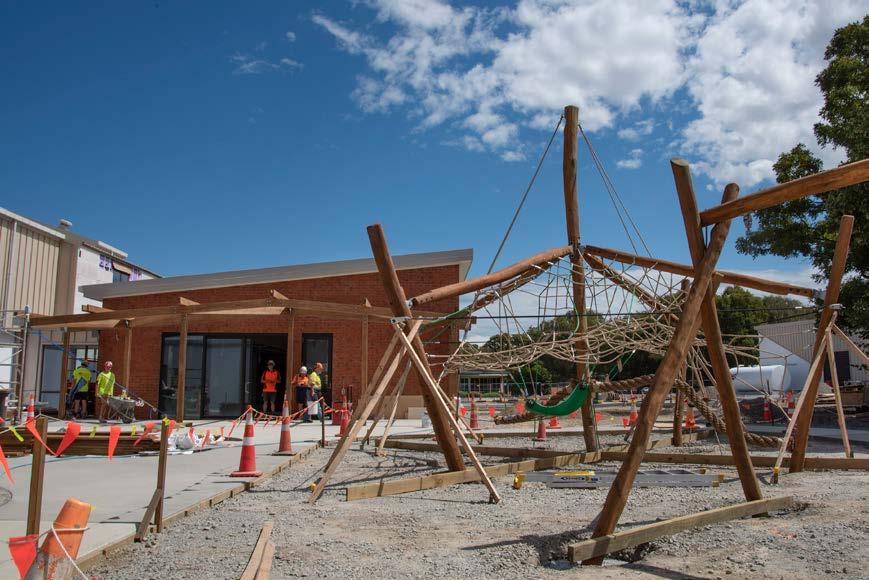Health New Zealand Canterbury News





Issue No.35






11 April 2023 Te Whatu Ora Waitaha Pānui
In this issue
Kupu Arataki – Introduction... pg 3-5

› Quiz – New Zealand Prime Ministers... pg 6
Ā mātou korero – Our people
› Young security guard joins the Ashburton team ... pg 7


› One minute with… Yukako (Koko) Yokojima, Health and Safety Advisor... pg 8

› Akoranga reo Māori – lesson #9 Te Taura Whiri i te reo Māori – Māori Language Commission... pg 9
› International winter warmer recipes... pg 10
› Whakamihi – Bouquets... pg 11–12
Ā mātou korero – Our stories
› Hillmorton facilities update... pg 12-13

› March 15 symposium – the psychological impacts of the Christchurch terrorist attacks ... pg 14-15

› Jammies for Juniors... pg 16
› World Parkinson’s Day... pg 17
› Creating accessible information and documents... pg 18
Pānui – Notices ...pg 19–20
2 11 April 2023 13 8 14
4 7
Cover photo: Progress photos of the construction of new facilities on the Hillmorton campus.
Thank you to everyone who worked over the Easter long weekend
Hopefully those lucky enough to have some time off over Easter had a fantastic and relaxing weekend. To the people who worked and cared for our patients, consumers and community, as well as those who made sure that our facilities continued to operate smoothly, thank you!

While the urgent care facilities were generally busy, presentations to the Christchurch Emergency Department over Easter were similar to a normal weekend.
It seems that great care was taken all over Aotearoa with only one road death in the whole country over Easter – the lowest since we were in Level 4 lockdown three years ago when there were no fatalities.

Staff flu vaccination clinics are underway
All Te Whatu Ora Waitaha Canterbury employees are eligible to receive a free flu vaccination which is available now.
It’s important to protect yourself from the flu in 2023 as it is expected to be another difficult winter, and not just for those in the health system. Schools, businesses and the broader community are likely to be hit hard with the flu and they will be seeking health care and advice from general practices, hospitals and urgent care facilities that are already overwhelmed. Let’s not add ourselves to the sick list this winter.
The flu vaccine helps protect you from catching the flu and reduces the risk of spread. If you do end up getting influenza, the vaccine reduces the severity of your symptoms and you are far less likely to become seriously ill or require medical intervention or hospitalisation.
Find the best vaccination clinic for you on PRISM and don’t forget to bring your completed and signed consent form with you.
REMINDER: Although it is generally safe for people to have the flu vaccine at the same time as their COVID-19 vaccinations/booster (including the new bivalent booster) the staff flu clinics will not be offering COVID-19 vaccinations.
If you’re due for your COVID-19 booster, you can find your nearest clinic here and if you prefer to pre-book, go to: https://bookmyvaccine.health.nz/

3 11 April 2023 Kupu
Introduction
Arataki –
New Director of Workforce appointed
Last week John Snook assumed the role of Director of Workforce. John leads the strategic direction for our health workforce and will continue to develop workforce strategies and initiatives. This includes growing our Te Whatu Ora workforce through education, training, recruitment and immigration initiatives, and driving and enabling workforce retention initiatives.
Working in partnership with Te Aka Whai Ora, John will ensure a strong focus on Te Tiriti o Waitangi and health equity. This includes health workforce initiatives focused on Māori and Pacific peoples, to ensure we have a well-supported workforce that meets the needs for our health system today and into the future.


Māia Health Foundation fundraiser

Tickets are still available for the Māia Health Foundation fundraiser. Hosted by Jason Gunn, the event is raising money for the foundation’s current key project, to help create a modern Child, Adolescent and Family Service outpatient facility on the Hillmorton campus. This will provide a new environment that is contemporary, welcoming, and recovery-focused, and supports the wellbeing of children, adolescents, and their whānau. It will be a place where people feel safe and respected when accessing mental health services at any stage of their wellness journey.
A fine selection of drinks and canapés are included in the ticket price.
When: Friday 28 April

7pm until 11pm
Where: The Great Hall, The Arts Centre
Book your tickets here
4 11 April 2023
Director of Workforce, John Snook
Volunteers needed for Meals on Wheels
The Red Cross is calling for volunteers to assist with the delivery of Meals on Wheels in Christchurch, Kaikōura and throughout Canterbury.
Meals on Wheels provides a critical service to older, ill and disabled people living at home who would otherwise struggle to provide healthy meals for themselves.


Shifts are flexible, however most drivers deliver meals once every couple of weeks.
The volunteers’ tasks are simple:
› Start your shift between 10:30am and 12pm
› Pick up meals in your car
› Deliver to clients and have a brief chat at the door
› Go home knowing that you’ve helped someone out today.

Volunteer requirements and training:
› Must be at least 18 years of age
› A valid driver’s licence
› A roadworthy vehicle with valid registration and warrant of fitness
› Two character references
› Four to eight hours of training will be provided
› All volunteers will be Police vetted.
To learn more and apply to be a volunteer, go to the Red Cross website here
5 11 April 2023
Quiz – New Zealand Prime Ministers
How much do you know about New Zealand’s leaders between 1856 and today?
1. Henry Sewell from Christchurch was New Zealand’s first official premier, taking office on 7 May 1856. How long did he serve?
a. 14 days
b. 14 weeks
c. 14 months
d. 14 years
2. How many times did Sir William Fox serve as premier of New Zealand?
a. Once
b. Twice
c. Four times
d. Six times
3. What did Prime Ministers Richard Seddon, William Massey and Norman Kirk have in common?
a. They were all Labour party leaders
b. They were all Liberal party leaders
c. They each served more than ten years as Prime Minister
d. They all died in office
4. Who became Prime Minister of New Zealand after David Lange?
a. Mike Moore
b. Geoffrey Palmer
c. Jim Bolger
d. Helen Clark
5. True or false. Jacinda Ardern was New Zealand’s youngest ever Prime Minister when she took office.
a. True
b. False
6. Jenny Shipley was New Zealand’s first female Prime Minister, taking over from Jim Bolger in 1997. How long did she hold the top job?
a. Six months
b. One year
c. Two years
d. Three years
7. Which New Zealand Prime Minister said: “Will the United States pull the rug on New Zealand? The answer is no. They might polish the lino a bit harder and hope that I execute a rather unseemly glide across it.”?
a. Rob Muldoon
b. David Lange
c. Mike Moore
d. John Key


8. In 1976, who was the first New Zealand Prime Minister to visit China?
a. Robert Muldoon
b. Bill Rowling
c. Hugh Watt
d. Norman Kirk
9. What was significant about the 1996 reelection of Jim Bolger as Prime Minister?
a. It began his fourth term as Prime Minister
b. He announced his resignation immediately after
c. It was the first election held under the new mixedmember proportional (MMP) electoral system
d. The National Party actually got less votes than Labour
10. When Chris Hipkins took over from Jacinda Ardern earlier this year, he became Prime Minister number ____?
a. 38
b. 39
c. 40
d. 41
Check your answers on page 19
6 11 April 2023
Young security guard joins the Ashburton team
Ashburton Hospital’s newest security recruit is enjoying her role and grateful for the support that helped make it a reality.
Micheala (Micky) Currie, aged 23, is in her third week working at the hospital. She is on duty overnight with the Allied Security team, making sure the hospital and its surrounding buildings are locked and safe and escorting staff to cars when they leave during the hours of darkness.
Ashburton Mayor Neil Brown visited Ashburton Hospital to meet Micky as she is the first local young person to land a job as part of a programme run by the Mayors Taskforce for Jobs
Micky says support from the taskforce’s Youth Employment Coach Sharon Watson had been instrumental in her landing the job, which she was enjoying.
“The interview was the scary part for me, but Sharon was allowed to be there in support, so it became more like a conversation.”
Funds from the taskforce programme also helped her buy clothes she would need on the job.
Operations and Administration Manager, Ashburton and Rural Health Services, Philippa O’Neill says Te Whatu Ora is excited to be a part of this local council initiative and looks forward to continuing to support the programme.
Mayor Brown says it is great to see this first placement and four others are in the pipeline.
“This programme is really important in helping young people who are not in employment, training or education, into jobs that help our community tick. We know there is a shortage of labour in parts of our district and that there are young people out there who could do the work, given a chance and some training.”
The Mayor's ‘Taskforce For Jobs’, in partnership with the Ministry of Social Development, has set up a Rural Community Resilience programme and Ashburton District Council is running a pilot programme for six months.


7 Ā mātou
11 April 2023
tāngata – Our people
Ashburton Hospital Security Guard Micky Currie (centre) with from left, Youth Employment Coach Sharon Watson, Operations and Administration Manager, Ashburton and Rural Health Services, Philippa O'Neill, Ashburton Mayor Neil Brown and Shaun Owers of Allied Security
One minute with… Yukako (Koko) Yokojima, Health and Safety Advisor

What does your job involve?
As a member of the Health and Safety team I provide technical advice and guidance to support managers, provide health and safety initiatives, and promote a proactive Health and Safety culture. I also deliver Health and Safety-related training. When it comes to a serious event, I carry out a response and investigate the cause of the incident.
What pathway got you to this job?
In my past career, I always had some Health and Safety responsibilities as part of my role, which drove me to look after, not only employees, but also visitors, contractors and clients. I started off working here as a Health and Safety Coordinator, supporting the Health and Safety advisors and our people across both Waitaha Canterbury and Te Tai o Poutini. The role was a great stepping stone into the healthcare sector, giving me the opportunity to openly engage with the amazing kaimahi in this organisation and our key stakeholders. It was a very good pathway into my current Health and Safety Advisor role and helped me to learn how Health and Safety systems operate here.
What advice would you give someone keen to enter your field?
I often get asked about what qualifications are needed to be a Health and Safety Advisor. My answer to that is yes,
qualifications are important, but so is having excellent interpersonal skills and engaging well with people. Health and Safety practices are endless. You’ll be learning new skills, knowledge and techniques for the whole of your career – that’s what makes it exciting.
Who inspires you and why?
My mum and papa (father). When I was growing up, our house was full of vibrant people, a place where my parents invited others to come and chat over a cup of tea. I heard so many funny stories over the years – from relationship issues to politics and medical advice. All of that gave me a great perspective in life and contributed to me genuinely wanting to offer unconditional help and support to others. If I can make a small positive difference in people’s life, that a huge win for me.
What do Waitaha Canterbury’s values (Care and respect for others, Integrity in all we do and Responsibility for outcomes) mean to you in your role?

The reason I work here and enjoy my time here is because my core values of who I am, align with those of Te Whatu Ora. They are very important to me personally. I also believe that, to be successful in my role, it is necessary to have these values, because this job is all about people and caring for their health and safety.
If you could be anywhere in the world right now where would you be?
Japan. I’d love to say at a tropical resort where I can enjoy cocktails and endless spa experiences, but at this point, I would just really love to be with my family. The older I get, the more I really miss the opportunity for precious time and moments with family.
Who would you want to play you if there was a movie made about your life?
Michelle Yeoh for sure! She is a very talented actress and I think she would be a perfect fit.
What are your hobbies/interests outside of work?
I love collecting cookbooks, from traditional cookbooks to trendy ones! I am not a great cook, but I love to pretend to be a good cook!
If you would like to take part in this column or would like to nominate someone please contact Naomi.Gilling@cdhb. health.nz.
8 11 April 2023
Akoranga reo Māori – lesson #9
Te Taura Whiri i te reo Māori – Māori Language Commission

E aku tini, e aku mano e tokotoko ana i tō tātou tōpūtanga, tēnā anō koutou. Hello again to you, the masses, propping up our organisation.
Kua pēhea te haere? How has it been going? Kua whai painga tēnei kaupapa?
Have you found this initiative beneficial?
Kaua e wareware kia whakamōhiotia mai mā te īmēra o raro – Don’t forget to let us know using the email below.
This week will be a little bit different. A bit of a public announcement of sorts as there have been many requests of late around bilingual signage for different facilities around our organisation.
Te Taura Whiri i te reo Māori is the Māori Language Commission and it provides the best practice guidelines for the use of written Māori and standards for publication. The Commission has also produced a particularly useful resource concerning best practice and for the use of te reo Māori in bilingual signage. The link below will take you directly to the resource. We must also remain mindful of Te Whatu Ora direction around signage, as well as consulting with the facilities division before making any permanent changes around our buildings.
Here is a very small excerpt to help support quality bilingual signage.
› Have the font for the Māori text at least as large as the font for the English, even if one text runs longer
› Use an equal typeface for the Māori and English
› Use the same font style for Māori and English
› Apply colour coding to text and or language separating background panel
› Be consistent in all signs with the same colour and position for each language
› Consider how a pictogram might reduce the amount of text required
› Place Māori first, either stacked or side by side
› If both Māori and English cannot be easily read because signage is ‘visibly busy’, consider having the Māori only
https://www.tpk.govt.nz/docs/bilingual-signage/tpk-bilingual-signage-guide.pdf
I mōhio rānei kwoe? Did you know?
On 13 April 1982, the first Kōhanga Reo (Māori language pre-school) opened in Wainuiomata in response to the decline in the use of te reo Māori. Within three years, there were 300 Kōhanga Reo throughout Aotearoa New Zealand.
Tēnā koutou katoa. Whakamahia te reo Māori, hei reo o ia rā, o ia rā. Thank you all, use the Māori language as an everyday language.
If you have any questions or feedback, please make contact via the email below. Hauora.Maori@cdhb.health.nz
9 11 April 2023
International winter warmer recipes
Name: Fry bread
Country of origin: A traditional Māori recipe from Aotearoa New Zealand

Dish: Bread (vegetarian)
There are variations to this recipe based on personal taste and whānau traditions. You may find versions with different ingredients online and in family recipe books across the country.

Makes 8-10 large pieces
Ingredients:
› ½ cup water
› ½ cup milk
› ½ tbsp dried active yeast
› ½ tbsp sugar
› ½ tbsp plain flour
› 2 cups plain flour
› 1 pinch salt
› 2 tbsp canola oil
› Extra oil for frying
› Extra flour for dusting
Method
Combine the water, milk, yeast, sugar and ½ tbsp of plain flour in a bowl and set aside in a warm part of the kitchen for 10 minutes. The mixture will begin bubbling and become sponge like. This is the yeast activating.
In a large bowl, combine the 2 cups of plain flour, salt and canola oil. Slowly add the yeast sponge to the dry mix. Fold together gently being careful not to overmix. There will be lumps, this is okay.
Cover the dough with plastic wrap and leave to proof in a warm part of the kitchen for approximately 30 - 40 minutes. It should double in size.
“When we were kids, fry bread was a special treat mum would whip up when guests came over. We were always so happy to help taste test the first batch. Cream and golden syrup always went down a treat.”
Remove dough from the bowl onto a lightly floured bench. Roll to a 2cm thickness and cut into 6cm x 6cm squares. Cover the dough with plastic wrap and leave to proof? on the bench for 15 minutes. Heat a medium size pot of oil to 165°C. Gently place dough in the hot oil, two or three at a time, and cook until golden brown.
Once cooked, remove from oil and drain on a paper towel. Allow to rest for five minutes before serving.
Serving Suggestion: Serve with jam and butter and cream or butter golden syrup.
We would love you to share your favourite winter dishes from around the world. Hearty, healthy (or a little naughty is okay too!), tasty and simple dishes that express your culture, a place that means a lot to you, or just food you love to eat. Click on this link to submit. If you have any issues, please email communications@cdhb.health.nz
10 11 April 2023
Kern Chai and Adam, and Ward B6, Ward A5 and surgical staff, Christchurch Hospital
I had the misfortune to be admitted to hospital recently after a chemo round. The team in Ward B6 looked after me very well. Dr Kern Chai and Adam discussed all relevant details and referred me to a surgical team. Had my gallbladder removed and the team in Ward A5, under trying times, looked after me. Shout out to Kern, Adam, the operating staff and the ward staff. You are all doing an amazing job under high pressure.
Ward 24, Christchurch Hospital

My son was in your care for some weeks and our family is most grateful for the special care and interest you took with him. It was most helpful to have the extra support as [patient name] is more relaxed and accepting when he knows people are interested in him. The family members who visited him noticed his acceptance of his situation. His siblings join me in expressing their appreciation too.

Tamara Glyn and other staff, Christchurch Hospital
I recently spent almost two weeks in Christchurch Hospital after an operation to remove a cancerous growth from my bowel. The operation was carried out by Tamara Glyn and a team of dedicated doctors, nurses and technicians. From my time in post-op through to recovery in Ward A5, I experienced nothing but the most professional care from the doctors and nurses I encountered. I observed your staff, especially the nurses, carrying out their duties in a very positive manner, despite sometimes working longer hours than their shift required. My sincere thanks for what was probably a life-saving experience for me.
Chris, Ruby, April, Vanessa, John, and Ali, Cardiology Day Unit, Christchurch Hospital
I was so well looked after by all the staff from the time I presented to the time I was discharged. I felt at ease and had a few laughs with the nurses and surgical team which was a great thing to keep me relaxed until I was put to sleep. Thank you to Chris, Ruby, April, Vanessa, John and Ali. All smiles, I had a wonderful team. Thank you.
11
11 April 2023
Whakamihi – Bouquets
Rebecca and Karen, Christchurch Hospital
I came in recently with a broken finger. I have severe anxiety and I was a little freaked out. Plastics Registrar Rebecca was just fabulous and so very helpful and kind. The X-ray lady was so awesome, as was Karen the nurse. I know that you all have been under a lot of pressure with staffing shortages and lots of sick people, so I just want to say how so grateful I was for the care shown to me by your staff. Thank you.
Roxanna, nurses and clerical staff, Emergency Department (ED), Christchurch Hospital
A huge thank you to Dr Roxanna in ED for taking care of my husband. She went above and beyond to make sure he was well looked after. We were so nervous having to come to the ED but her obvious skill as a doctor, plus her compassion and humour made it all ok. The nurses and clerical staff were fabulous too, calm and professional.
Sharon Bolitho and Day Surgery Unit staff, Christchurch Women’s Hospital
I want to thank everyone involved in my care for making me feel comfortable and answering all my questions. I would also like to thank Dr Sharon Bolitho for being a friendly and familiar face. I felt comfortable and safe.
Hillmorton facilities update

The construction of the new facilities on the Hillmorton campus has reached an exciting stage with more progress made on internal fitout and some of the outdoor features, including the children’s playground

Each week more takes shape and we are a step closer to moving the services from The Princess Margaret Hospital.

Building 12 will provide adult inpatient services and the larger Building 14 will serve Eating Disorders and Mothers and Babies Inpatient and Community Outpatient Services, Child Adolescent and Family Inpatient Services and Day Programme, and the Southern Health School.
Carolyn, Bray and Dr Adeline Kho, Eye Outpatients, Christchurch Hospital
I contacted Eye Outpatients and got to speak to Carolyn who was amazing, she made some enquiries and with the help of Bray, managed to fit Mum in to see Dr Adeline Kho, who is an angel as well. Within two weeks we were able to go to Christchurch Eye Outpatients and the procedure was done in a few minutes. By the time we got back to Ashburton, Mum had clear sight in the eye treated and was a lot happier as were all the staff at her rest home. The staff and the doctor who performed the procedure were amazing – patient and understanding. We appreciate all the effort they made to make it happen and how much positive difference they have made to a 92 yearold’s life. It was truly life-changing.
Dr John, Christina, Kathy, Elspeth, Allen, Bincy, Alex - Ward B8, Christchurch Hospital
Thanks so much to the team for the amazing care given to my father. I was blown away by the degree of attention and care given to him by all the nurses and the whole medical team. I met the surgeon Dr John and Anaesthetist Christina. So, many thanks to Kathy, Elspeth, Allen, Bincy, Alex and everyone else who gave such detailed, thoughtful and precise care to my father.
12 11 April 2023
The playground outside Building 14
The children's courtyard - Building 14
mātou kōrero – Our stories







13
11 April 2023
Ā
Building 12
Staff area with meeting and breakout rooms in Building 14
A bedroom in Building 14
View out to a courtyard - Building 12
Playground under construction
Building 14 with the playground on the right and future site of a basketball court
March 15 symposium – the psychological impacts of the Christchurch terrorist attacks

The terror attacks on two mosques in Christchurch four years ago were unprecedented in Aotearoa New Zealand.
In an effort to understand the effects of these devastating events on the Christchurch Muslim community, the University of Otago and Christchurch’s Department of Psychological Medicine initiated The March 15 Project – to study the psychological aftermath of the terrorist attacks, and to understand them within the context of similar incidents internationally.
Preliminary findings from The March 15 Project were presented in a day-long symposium held at the campus’ Rolleston Lecture Theatre on 21 March, showcasing work from the project’s research team alongside guest lectures from international speakers in the field of incident trauma.

The March 15 Project is collaborative, involving University of Otago Christchurch campus, University of Canterbury and Te Whatu Ora Waitaha Canterbury, and is funded the Health Research Council of New Zealand and the Canterbury Medical Research Foundation.
The symposium opened with a karakia from kaumatua Rangihau Te Moana, followed by a dua (prayer) from Imam Ibrahim Abdelhalim. Dean and Head of Campus Professor Suzanne Pitama welcomed attendees – including many from the city’s Muslim community.
March 15 Project Researchers Caroline Bell and Ruqayya Sulaiman-Hill gave the first presentation, discussing findings from the first phase of their long-term study into the impacts on members of the community directly affected by the attacks.
They spoke of the challenges associated with conducting research in such a highly-exposed population, and the requirements they needed to meet to establish a culturally-responsive, participatory and trauma-informed design process.
They noted the impacts and challenges the tragedy inflicted upon the wellbeing and mental health of closely-affected community members. However, they also spoke of self-reported positive outcomes from many participants - including high levels of measures rating religious coping and posttraumatic growth.
A qualitative study presented by Project CoResearcher Shaystah Dean provided a deeper understanding of some of the unique challenges that participants faced and how they coped. The Project team concluded that taken together, these findings will be helpful for the Muslim community in planning the ongoing support services they require.
This was followed by a presentation from Martin Dorahy from the University of Canterbury, discussing the impacts of the mosque attacks on the New Zealand population as a whole.
14 11 April 2023
The March 15 Symposium
Using data from the New Zealand Attitudes and Values Surveys recorded both before and after the attacks, his findings show both an increase in terrorism anxiety and an increase in the sense of community following the incidents, yet no reported changes in either psychological distress or wellbeing.


He discussed how this delivers insight into the psychological implications of politically-motivated violence on the wider population when terrorism is directed toward a specific minority group. In the aftermath of the attacks, members of the March 15 Project research team, including Caroline and Head of the Department of Psychological Medicine Richard Porter, consulted widely with international researchers – who they say were generous in giving of their time and expertise.
One was Lori Zoellner from the University of Washington’s Department of Psychology, and Director of the University of Washington Centre for Anxiety and Traumatic Stress in Seattle. Lori, the first of two international guest speakers to present at the symposium, reported findings from her groundbreaking Islamic faith-based, community-led programme, developed to support Somali refugees in the United States and a similar programme in Somalia.
Following lunch and prayers, Linwood mosque survivor and Researcher Mazharuddin Syed Ahmed, discussed findings from his work, outlining the positive impacts of publicly written messages and acts of aroha on those most closely affected by the mosque attacks. Mazhar provided a personal and moving description of this, explaining how widely and swiftly this community support spread. His research examines how aroha can combat negative and racist messages promulgated through social media.
Director of the Phoenix Australia Centre for Post Traumatic Mental Health from within the Department of Psychiatry at the University of Melbourne, David Forbes, was the symposium’s second international guest speaker. He provided an overview of his extensive experience managing community responses following trauma, with a focus on the Australian bushfires. He also discussed the impacts of multiple trauma on populations as a whole, and various interventions for recovery.
Concluding the symposium on a positive note, Richard discussed findings from his body of research into the effects of trauma on the brain. His results have shown that although people affected by the 2010-2011 Christchurch earthquakes experienced changes in brain function two years after the events, these changes had reverted to normal healthy levels seven to eight years later.
15 11 April 2023
Jammies for Juniors
With the weather getting cooler, Christchurch Hospital Volunteers have restarted their ‘Jammies for Juniors' programme.
They are asking for donations of new pyjamas in children's sizes one to 16. The pyjamas will be given to children and young people staying in the hospital.
“This is especially handy for children to change into after any accidents on the ward, especially after a seizure or even for an unexpected hospital stay,” says Volunteer Coordinator Louise Hoban-Watson.
It is important to note that due to the risk of infection, only new flannelette pyjamas will be accepted. All pyjamas must meet the New Zealand product safety standards and carry the fire safety certification (look for the ‘caution keep away from heat’ label).
Some of the pyjamas that have been donated
“Some pyjamas have already been received and it’s so wonderful to have kind people looking out for our little ones,” Louise says.

The pyjamas must also have buttons down the front.
Suggested retailers are, but not limited to, Farmers, The Warehouse, Postie Plus, Kmart, Cotton On, Bed Bath & Beyond and Peter Alexander.
Donated pyjamas must be dropped off at Christchurch Hospital, either at the main Reception desk, the Volunteers' Office or to a WayFinder volunteer (they wear a blue ‘Can I help you?’ vest).
Donated pyjamas must:
› be in children's sizes 1 - 16
› be new and flannelette

› have button-up tops
› meet New Zealand product safety standards

16 11 April 2023
World Parkinson’s Day
Today, Tuesday 11 April is World Parkinson’s Day which was established in 1997 to coincide with the birthday of Dr James Parkinson, who was the first physician to recognise the medical condition.
Parkinson had no idea when he wrote ‘An Essay on the Shaking Palsy’ in 1817 about symptoms he observed in at least three of his patients, that some 60 years later the very condition he described would be named after him.
In the 19th century, Parkinson incorrectly surmised that the tremors in these patients were due to lesions in the cervical spine. We now know that Parkinson’s is a progressive neurodegenerative condition caused by insufficient quantities of dopamine – a chemical in the brain. Dopamine enables quick, well-coordinated movement. When dopamine levels fall, movements become slow and awkward. Parkinson’s has both motor and nonmotor symptoms, and while it cannot be cured it can be treated.
Parkinson’s can progress quite slowly and often it takes years for symptoms to develop. It has very little effect on life expectancy. Around one in 500 people have or will develop the condition with it affecting mostly older people. The average age of diagnosis is 59.
The three main symptoms of Parkinson's are:
› tremor
› stiffness and
› slowness of movement.

People may also experience other symptoms including pain, problems with sleep and depression, anxiety or apathy.

There are no particular tests to easily diagnose Parkinson’s so a variety of techniques (usually based on clinical examination and medical history) are used.
The profile of the condition has been raised in recent years due to some famous people with Parkinson’s, including Muhammed Ali, Billy Connolly and Michael J Fox who established the Michael J Fox Foundation for Parkinson’s Research
World Parkinson’s Day is intended to raise awareness of the condition and the challenges for those living with it. There are also opportunities for people to donate money towards ongoing research
You can also read stories of New Zealanders living with Parkinson’s here.

17 11 April 2023
Creating accessible information and documents
This is the 10th item in the series providing tips on creating accessible information and documents. For previous tips refer to Tips and tools
Customise the text for a Hyperlink
If you’ve ever added hyperlinks to a message, you probably already know that URLs can get long and ugly. You can change the link text to something easier to read that tells people what the link is about.
Change an existing hyperlink
If there’s already a hyperlink in your message but the link text doesn’t mean anything (except to a computer), follow these steps to change it:
1. Right-click anywhere on the link and, on the shortcut menu, click Edit Hyperlink.
2. In the Edit Hyperlink dialog, select the text in the Text to display box.
3. Type the text you want to use for the link, and then click OK.
Add a hyperlink to existing text
If you just want to format existing text into a hyperlink:
1. Select the text that you want to turn into a hyperlink, and right-click it.
2. On the shortcut menu, click Hyperlink.
3. In the Insert hyperlink dialog, paste the link in the Address box and click OK.
Note: It doesn’t help if the hyperlink is renamed “Click Here” or “To Continue”. This doesn’t tell people what the link is about. It is better to put some descriptive information in the hyperlink. That’s particularly as some people scroll through a list of links and getting “Click Here”, “Click here”, etc, isn’t helpful.
How to write hyperlink text for better web accessibility
1. Be descriptive and accurate.
2. Don't duplicate link text on the same page.
3. Avoid generic phrases like 'click here' and 'read more'
4. Avoid hyperlink text that's longer than a sentence.
5. And avoid hyperlink text that's only one or two characters.
To learn more about creating accessible information, look out for further items in future pānui. For any queries, please contact Communications on Communications@cdhb. health.nz

18 11 April 2023
Something For You
Something for You is the Te Whatu Ora - Waitaha Canterbury employee benefits programme. The deals offered are from the New Zealand business community to say thank you for all that you do. Please see below offers for you.

Harvey Norman – Christchurch Central, Northwood, Hornby, Tower Junction
Discounted rates when you present with your staff ID for all Waitaha employees, simply speak to staff as the amount can vary from product to product.
Millennium Hotels

Receive 20 percent off the fully flexible rate at Grand Millennium, Millennium, Copthorne, Kingsgate and M Social Hotels in New Zealand, see more information here
Warehouse Stationary – 11-13 Winchcombe Street, Central City (South City)

When shopping at the South City Branch, get 20 percent off all stationary, art, craft and furniture instore. Details on how to redeem here

This unique staff offer has been extended until 31/12/23 by using our special access code found here.
Mole Check- 143 Aikmans Road, Merivale
Get 22 percent off the standard full Mole Check rate ($230 per patient, usually $295 per patient) - show your staff ID to redeem.

QUIZ ANSWERS – Great British comedies
1. a. 14 days
2. c. Four times
3. d. They all died in office
4. b. Geoffrey Palmer
5. b. False – Jacinda Ardern was 37 years and 13 weeks old when sworn in as Prime Minister. New Zealand’s third Prime Minister Edward Stafford was 37 years and five weeks old when sworn in.
6. c. Two years
7. b. David Lange
8. a. Robert Muldoon
9. c. It was the first election held under the new mixed-member proportional (MMP) electoral system
10. d. 41

Pānui – Notices 19 11 April 2023
Wednesday 3rd May 10:00am – 3:00pm


Please book your appointment to donate. Remember to eat & drink plenty beforehand & bring your donor card or photo ID. Eligibility criteria applies


20 11 April 2023
– Annex Room
to the Great Escape Café
Chch Hospital
Next




















































